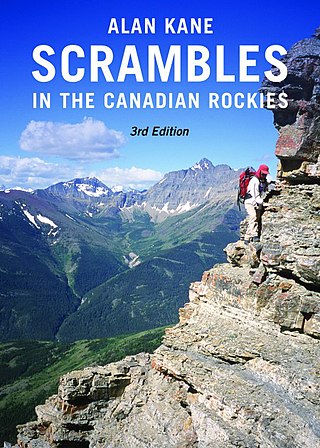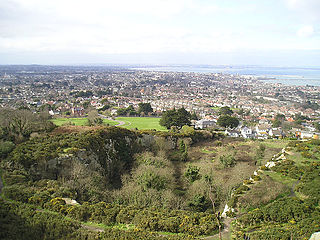Related Research Articles
Rock climbing is a popular activity in the Peak District; particularly on edges such as Stanage or Froggatt. Generally the climbing style is free climbing and the rock is either gritstone or limestone. Climbing has been practised in the Peak District since the late 19th century; James W. Puttrell is generally credited with starting the sport. The first climbing guidebook to the area was Some Gritstone Climbs, by John Laycock, published in 1913. There are over 10,000 routes in the Peak District. One of the most famous Peak District climbers, and a pioneer of many new routes, is Ron Fawcett. The climb known as "Master's Edge", on Millstone Edge, near Hathersage, is a testament to his skill and strength. The climb is graded E7 6c and rises 19m up the near vertical edge.

Many climbing routes have a grade that reflects the technical difficulty—and in some cases the risks and commitment level—of the route. The first ascensionist can suggest a grade, but it will be amended to reflect the consensus view of subsequent ascents. While many countries with a strong tradition of climbing developed grading systems, a small number of grading systems have become internationally dominant for each type of climbing, which has contributed to the standardization of grades worldwide. Over the years, grades have consistently risen in all forms of climbing, helped by improvements in climbing technique and equipment.

Scrambling is a mountaineering term for ascending steep terrain using one's hands to assist in holds and balance. "A scramble" is a related term, denoting terrain that could be ascended in this way. It can be described as being between hiking and rock climbing.

The British Mountaineering Council (BMC) is the national representative body for England and Wales that exists to protect the freedoms and promote the interests of climbers, hill walkers and mountaineers, including ski-mountaineers. The BMC are also recognised by government as the national governing body for competition climbing.

Sgùrr Dearg is a mountain in the Cuillin on the Isle of Skye, Scotland. It is topped by the Inaccessible Pinnacle, a fin of rock measuring 50 metres (160 ft) along its longest edge. The top of the Pinnacle stands at 985.8 m (3,234 ft) above sea level, making Sgùrr Dearg the only Munro with a peak that can only be reached by rock climbing. This makes it the biggest hurdle for many Munro baggers.

Climbing guidebooks are used by mountaineers, alpinists, ice climbers, and rock climbers to locate, grade, and navigate climbing routes on mountains, climbing crags, or bouldering areas. Modern route guidebooks include detailed information on each climbing route, including topo diagrams, route beta, protection requirements, and the ethics and style that are in place for a given climbing area.

Black Rocks, is a small outcrop of ashover gritstone, between Cromford and Wirksworth in Derbyshire, the Peak District, England. It is an important crag in the history of British rock climbing, and has some of the most extreme climbing routes in Britain, including Gaia E8 6c.

Geoffrey Winthrop Young was a British climber, poet and educator, and author of several notable books on mountaineering.
The American Alpine Club (AAC) is a non-profit member organization with more than 26,000 members. The club is housed in the American Mountaineering Center (AMC) in Golden, Colorado.
James Horst Brunnerman Bell (1896–1975) was arguably the leading Scots mountaineer in the period prior to World War II, going on to edit the SMC Journal for an unequalled 24 years from 1936 to 1959. He put up many serious routes on Ben Nevis and in many other areas of Scotland. One of his first ascents was "Long Climb", a 1400-ft Severe on the Orion Face of Ben Nevis - it is reputedly the longest in the UK and a chapter by Malcolm Slesser is devoted to it in the compendium of classic UK rock climbs "Classic Rock".

The Fell & Rock Climbing Club is the senior climbing club covering the English Lake District. It was founded in 1906–1907 and, amongst its other activities, publishes rock climbing guides to the area. It owns many of the early climbing photographs taken by George & Ashley Abraham, who were founding members.

The Climbers' Club is the senior rock-climbing club in England and Wales. The club was founded in 1898. The CC one of the largest publishers of climbing guidebooks in many of the main climbing areas of England and Wales. The club also owns and operates a number of climbing huts in England, Scotland, and Wales.

Dalkey Quarry is a long-disused 19th century granite quarry located on Dalkey Hill in the Dublin suburb of Dalkey, which was used to build several large maritime structures in south Dublin. Since passing into public ownership in the early 20th century and becoming part of Killiney Hill Park, it has become one of the most important rock climbing venues in Ireland, with over 350 graded routes, some of which are amongst the hardest single-pitch rock climbs in the country such as Indecent Assault. The climbs are all traditional climbing routes and no bolted sport climbing routes are permitted, although some metal pegs are tolerated on the most extreme routes.
Walking is one of the most popular outdoor recreational activities in the United Kingdom, and within England and Wales there is a comprehensive network of rights of way that permits access to the countryside. Furthermore, access to much uncultivated and unenclosed land has opened up since the enactment of the Countryside and Rights of Way Act 2000. In Scotland the ancient tradition of universal access to land was formally codified under the Land Reform (Scotland) Act 2003. In Northern Ireland, however, there are few rights of way, or other access to land.
The South Wales Mountaineering Club (SWMC) was established in 1960 and aims to encourage interest in mountaineering in all its forms, and to bring together like-minded people interested in mountaineering. The club's activities range from mountaineering and rock climbing to scrambling and hillwalking, catering for all level of experience including total beginners.
Ron Fawcett is a British rock climber and rock climbing author who is credited with pushing the technical standards of British rock climbing in traditional, sport, bouldering and free soloing disciplines, in the decade from the mid-1970s to the mid-1980s, and of pioneering the career of being a full-time professional rock climber. At the end of the 1970s to the early 1980s, Fawcett was widely considered the best and most notable rock climber in Britain.
Some Gritstone Climbs is a rock climbing guidebook written by British lawyer John Laycock (1887–1960). The book's subtitle, included uniquely on the frontispiece, is Some Shorter Climbs . It was published in Manchester in 1913 by the Refuge Printing Department. Although focusing on rock climbing in the Peak District, it covers several adjacent cliffs outside this region, and despite its title, referring to the Millstone Grit geology of many of the cliffs, it includes several cliffs consisting of other rock types, including mountain limestone and red sandstone.
Mountaineering Ireland is the representative association for hikers and mountaineers on the island of Ireland. It is recognized by both Sport Ireland, the Irish authority for sport, and Sport Northern Ireland, the corresponding authority of the Government of Northern Ireland, thus operating across the island of Ireland. The association has been an International Climbing and Mountaineering Federation (UIAA) member since 2004, as well as a member of other federations. The association is also a publisher of walking and climbing guides.
Kenneth John Wilson was a British writer, publisher and editor of books and magazines about climbing and mountaineering. The British Mountaineering Council's Summit Magazine described him as "one of the most influential voices in British climbing". In 1974 he edited and contributed to the first editions of the book Hard Rock which The Guardian considered was "among the most influential climbing books of the 20th century."
Paul James Nunn was an English mountaineer, and an author and economic historian.
References
- ↑ Grimes, Niall (29 August 2016). "Lancashire Rock, in stock and two smoking barrels". British Mountaineering Council . Retrieved 24 September 2023.